Spaghetti Sauce for Canning (Use Fresh or Frozen Tomatoes)
My husband came in from outside the first time I was canning spaghetti sauce, smiled and said the house smelled like an Italian restaurant – a good Italian restaurant. I had to agree.
This sauce takes a while to cook, but the end result is delicious! It’s great for pasta sauce, pizza or topping spaghetti squash. Gluten free and meatless (you can add meat just before serving if you like).
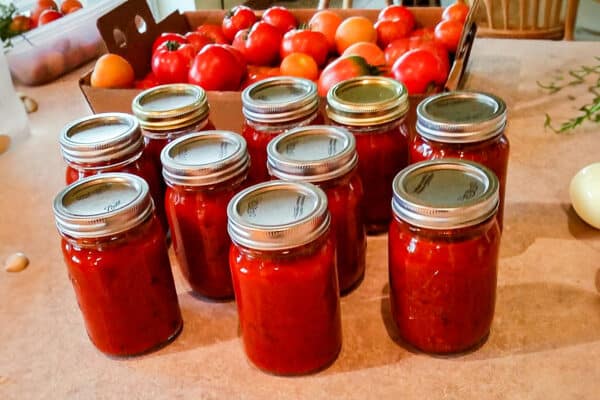
We take you through the recipe step by step with photos, plus share tips for working with frozen tomatoes. A good homemade spaghetti sauce recipe for canning is a must in our house, because many store bought spaghetti sauces use ingredients like genetically modified high fructose corn syrup and soybean oil – not things we normally eat.
I start a batch in the morning, and slow cook it while I’m working on other things in the kitchen, like prepping the rest of the ingredients and canning equipment. Paste tomatoes yield a thicker sauce with less cooking, but you can use any tomatoes that you have available.
Spaghetti Sauce Recipe for Canning with Fresh Tomatoes – Step By Step Instructions
(Scroll down to bottom of post for print friendly version of recipe.)
My favorite canning spaghetti sauce recipe is adapted from The Encyclopedia of Country Living by Carla Emery. This recipe is very close to the “Spaghetti sauce without Meat” recipe listed on the National Center for Home Food Preservation website, so you know it’s a safe canning recipe.
Salt and pepper can be adjusted to taste, or substitute Italian seasoning for the oregano. It’s okay to substitute an equal amount of fresh basil for some of the celery, green peppers or mushrooms.
You can also cut this spaghetti sauce recipe in half or to a fourth. Just keep the processing time the same, or freeze the marinara sauce in freezer bags or freezer safe containers instead of canning.
When we’re ready to serve the spaghetti sauce, we open a jar and heat it up, or brown some ground beef or Italian sausage and add the sauce to the skillet.
Ingredients
- 30 pounds tomatoes
- 1/4 cup butter or olive oil
- 1 cup chopped onions
- 5 minced garlic cloves
- 2 tablespoons salt
- 1 cup chopped celery or green pepper
- 1 pound sliced mushrooms (optional)
- 2 teaspoons black pepper
- 2 tablespoons oregano flakes
- 1/4 cup minced parsley
- 1/4 cup brown sugar or unrefined cane sugar
Directions
Wash 30 pounds of tomatoes. Remove cores and quarter tomatoes.
Cook 20 minutes, uncovered, in large pan or pans to soften tomatoes. I cook mine at medium high heat in an assortment of heavy bottom stainless steel pans. I have also used a Nesco roaster and a slow cooker.
Thick bottom pans prevent accidental scorching, frequent stirring is recommended. Don’t use aluminum – it will react with the acid in the tomatoes. When I cook on the stove top, I start with four pans and cook the sauce down to one 8 quart stockpot.
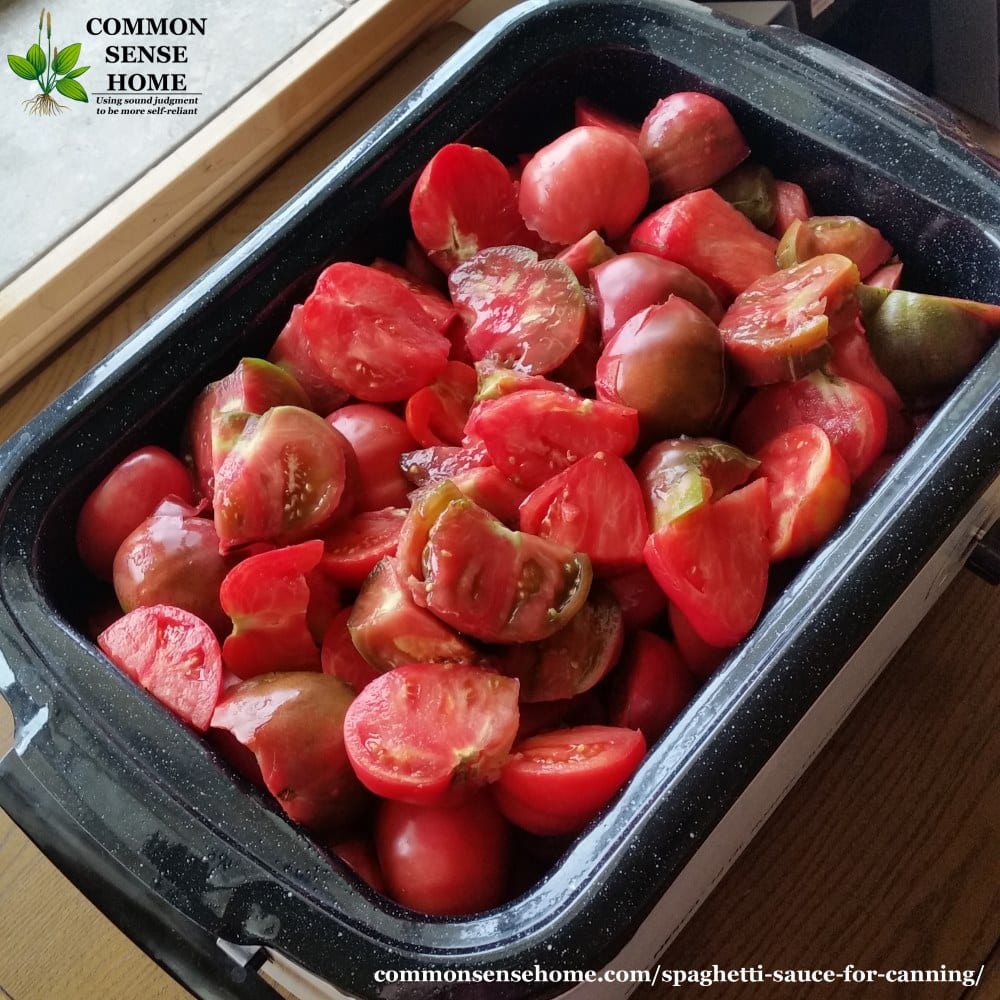
Put tomatoes through a food strainer or food mill. I have a Back to Basics food strainer that works beautifully. (The Back to Basics strainer isn’t available anymore, but this Norpro strainer is similar.)
Years ago I used a chinois strainer, and I still use it for small batches, but for large batches the food strainer can’t be beat. It’s so much faster!
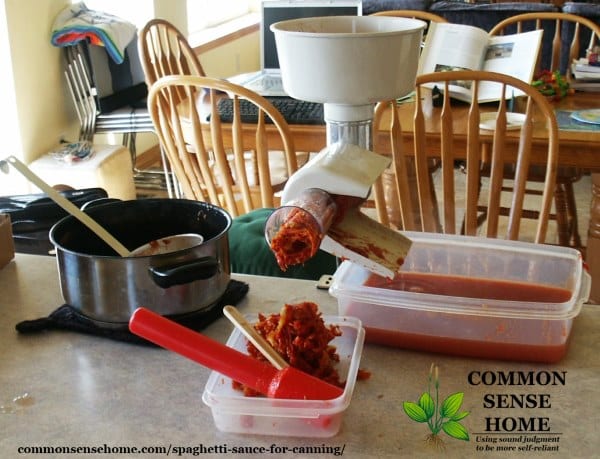
Cook down tomatoes to reduce volume and make a thicker sauce. We start with four pots and end up with one. This is the base of your spaghetti sauce.
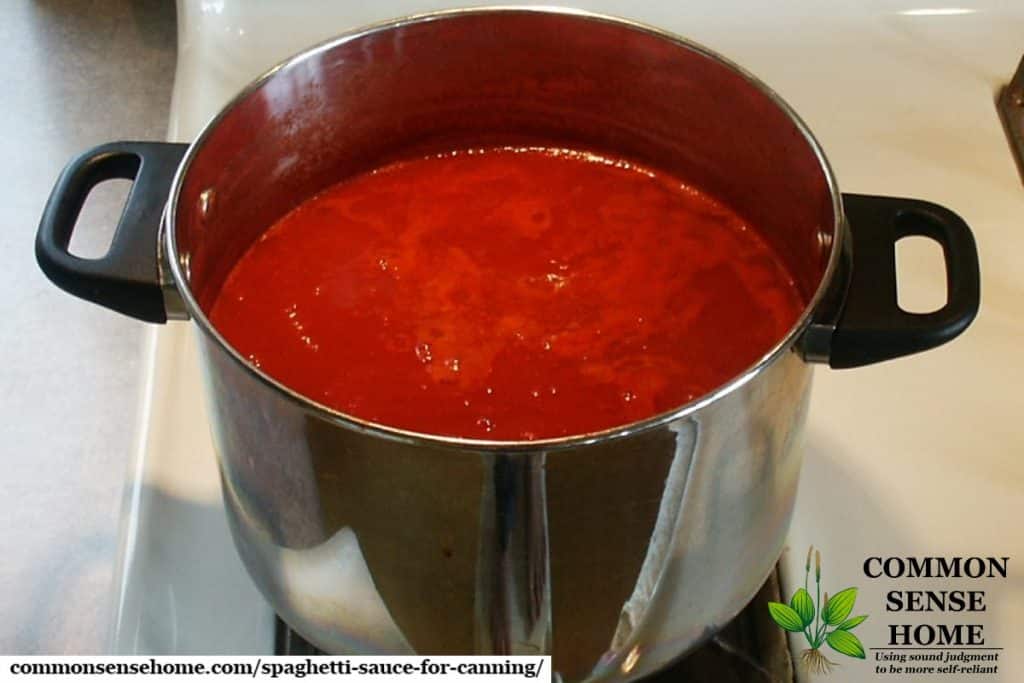
While the tomato sauce is cooking, you can do the rest of the prep work, like chopping the rest of your veggies, filling the canner, and getting the lids and jars ready.
My pressure canner uses three quarts of water, to which I add one tablespoon of white vinegar to reduce hard water build up on the jars. I wash my jars in the dishwasher and keep them hot until I’m ready to fill.
I keep my lids in hot water in a one quart saucepan (do not boil lids), and use kitchen tongs for lifting them out of the water. The latest generation of canning lids from Ball do not require preheating, but I have a stock of lids that I am still working through.
To Finish the Sauce
Sauté in 1/4 cup butter or olive oil until tender: onions, garlic, celery or green pepper, and mushrooms. Combine sautéed vegetables and tomatoes. Add salt, black pepper, oregano, parsley and sugar.
Bring to a boil. Stir frequently to avoid burning. Reduce heat to simmer, keep hot while waiting to process.
Canning the Spaghetti Sauce
Fill jars, leaving 1 inch headspace. Adjust lids. Process in a pressure canner 20 minutes for pints, 25 minutes for quarts.
If using a weighted-gauge canner, set at 10 pounds pressure at 0-1,000 feet above sea level; set at 15 pounds pressure at higher altitudes.
If using a dial-gauge canner; set at:
- 11 pounds pressure at 0-2000 feet above sea level
- 12 pounds at 2,001-4,000 feet
- 13 pounds at 4,001-6,000 feet
- 14 pounds at 6.001-8,000 feet
- 15 pounds above 8,000 feet
Allow canner to cool and release pressure. Remove jars and set on towel on counter. Let rest until cool, or overnight.
Remove rings, wipe any spills. Date and label and store in a cool, dry location, out of direct sunlight. Best used within 1-2 years.
Yields around eight pints of home canned spaghetti sauce.
What About Canning Spaghetti Sauce Without a Pressure Canner?
You need to use a pressure canner for canning this spaghetti sauce recipe, since it contains low acid ingredients like oil and onions. Freezing spaghetti sauce is a good option if you don’t have a pressure canner.
To use a water bath canner, the food you’re canning must have a pH of 4.6 or lower.
The homemade spaghetti sauce recipes with lemon juice added to make them safe for water bath canning taste like lemons to me, not tomatoes. I’ve tried them, but I can’t recommend them.
Citric acid lowers acidity without changing the flavor of the sauce, but there’s still the issue of the oil. Use the freezer instead.
See “How to Can Food at Home – Quick Guide to Safe Home Canning” for a review of safety basics.
How long does home canned spaghetti sauce last?
The flavor and nutrient levels in your home canned spaghetti sauce are best when used within one to two years. If you store the sauce in the freezer, try to use it within six months.
We’ve used a few home canned items at five years of age, but the flavor is not as good.
Never use a canned product with a broken seal, bulging lid or other obvious signs of damage or spoilage.
How do you thicken homemade spaghetti sauce for canning?
Low, slow cooking is my default option to thicken the sauce and concentrate the flavor of the tomatoes. Other options include:
Would you like to save this?
- Weigh and freeze the tomatoes, and then allow them to thaw in a colander to remove excess liquid before proceeding with the recipe.
- Can the sauce when it is somewhat thin, and then add tomato powder or dehydrated tomato puree to thicken when you heat the sauce for serving. I use this option when I make sauce out of cherry tomatoes or other very juicy tomatoes instead of paste tomatoes.
Some people grind up the skins and seeds to thicken the sauce. For our tastes, this made the sauce so bitter that we couldn’t eat it. Also, the skin and seeds of the tomatoes are where most of the lectins are.
Why Remove the Seeds and Skin?
Lectins are a type of protein that can bind to carbohydrates, and act as part of the plant’s self defense mechanism. They are difficult to digest, and may contribute to leaky gut syndrome. They may also have a negative effect on the immune system in sensitive individuals.
By removing the skin and seeds, we remove the majority of the lectins, making the tomato sauce easier to digest.
If You Don’t Have Enough Ripe Tomatoes from One Picking
If you don’t have enough ripe tomatoes at one time for canning spaghetti sauce, you can pop tomatoes that are very ripe or damaged into the freezer, until you have enough for the recipe.
I have found that ripe, undamaged tomatoes will easily keep for a week or more at room temperature. Cracked or otherwise damaged tomatoes will only last a day or two before spoiling and/or attracting fruit flies, so they should be processed in some manner within 24 hours, if possible.
I usually core the tomatoes and half or quarter them (depending on the size) before freezing. Then, when I am planning on canning spaghetti sauce the next day, I place them in the sink overnight to thaw. In the morning, you can pour off some of the clear juice if you like so that the cook down quicker. Weigh them out, dump them into your stockpot, and start cooking.
If you have fruit that’s refusing to ripen, check out “4 Reasons your Tomatoes Aren’t Ripening – And What You can Do About it“. If you have tomato blossoms, but no fruit, we have help for that, too.
Recommended Equipment for Canning Spaghetti Sauce:
Canned Spaghetti Sauce Recipe – Fresh or Frozen Tomatoes
Never buy spaghetti sauce from the store again.This homemade canning spaghetti sauce recipe is slow cooked and loaded with flavor. May also be used fresh or frozen if you don’t have a pressure canner.
- Prep Time: 5 hours
- Cook Time: 20 minutes
- Total Time: 5 hours 20 minutes
- Yield: 8 pints 1x
- Category: Sauce
- Method: Canning
- Cuisine: American-Italian
Ingredients
- 30 pounds tomatoes
- 1/4 cup butter or olive oil
- 1 cup chopped onions
- 5 minced garlic cloves
- 2 tablespoons salt
- 1 cup chopped celery or green pepper
- 1 pound sliced mushrooms (optional)
- 2 teaspoons black pepper
- 2 tablespoons dried oregano flakes
- 1/4 cup minced parsley
- 1/4 cup brown sugar or unrefined cane sugar
Instructions
- Wash 30 pounds of tomatoes. Remove cores and quarter tomatoes. Boil 20 minutes, uncovered, in large pan (or pans).
- Put through food strainer or food mill. Cook down tomatoes to reduce volume and make a thicker sauce. Reduce volume by 1/2 to 2/3rds.
- While the sauce is cooking, finish the remaining prep work, like chopping your veggies and getting the lids and jars ready. Prepare pressure canner according to manufacturer’s instructions.
To Finish the Sauce
- Saute in 1/4 cup butter or olive oil until tender: onions, garlic, celery or green pepper, and mushrooms.
- Combine sauteed vegetables and tomatoes.
- Add salt, black pepper, oregano, parsley and sugar.
- Bring to a boil. Stir frequently to avoid burning. Reduce heat to simmer, keep hot while waiting to process.
- Fill jars, leaving 1 inch headspace. Adjust lids.
- Process in a pressure canner 20 minutes for pints, 25 minutes for quarts. If using a weighted-gauge canner, set at 10 pounds pressure at 0-1,000 feet above sea level; set at 15 pounds pressure at higher altitudes. If using a dial-gauge canner; set at 11 pounds pressure at 0-2000 feet above sea level; 12 pounds at 2,001-4,000 feet; 13 pounds at 4,001-6,000 feet; 14 pounds at 6.001-8,000 feet; or 15 pounds above 8,000 feet.
- Allow canner to cool and release pressure. Remove jars and set on towel on counter. Let rest until cool, or overnight. Remove rings, wipe any spills. Date and label and store in a cool, dry location, out of direct sunlight. Best used within 1-2 years.
Nutrition
- Serving Size: 1 cup
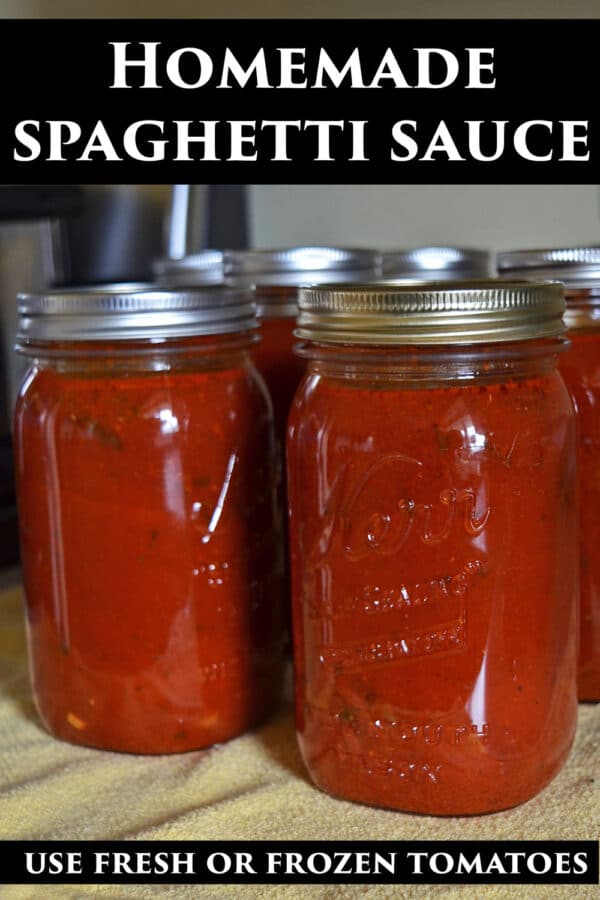

This article is written by Laurie Neverman. Laurie grew up in the kitchen, learning baking and home cooking from her momma. At age 15, she and her mom and two sisters created Irene’s Custom Cakes & Catering. This was her summer job through most of high school and college.
Originally published in 2009, last updated in 2024.

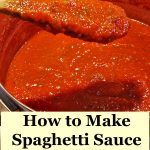
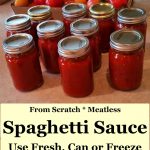
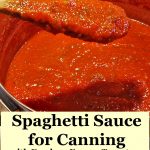
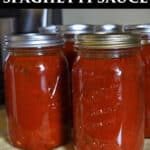
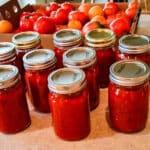
This information is very helpful! I did not weigh my tomatoes, so now I have a massive amount of tomatoes but don’t know what ratios to use. It’s also very confusing bc everyone cuts out more or less amounts of a tomato and I like to strain the liquid after I have frozen the tomatoes to skin them…
so my question is, what are my ratios if all I have is tomatoes sauce?
I don’t have a simple one to one exchange, because, as you noted, different tomatoes and different cuts will give different yields.
I’ve found that a gallon freezer bag, moderately full, weighs about 5 pounds. So six gallon freezer bags of tomatoes would be roughly 30 pounds of tomatoes. If you take the time to freeze in five pound bags, then you can grab and thaw them as needed for sauce making and have an easy way to keep track.
After straining, but before final cook down, I usually have two 8 quart stockpots full of tomato juice and other ingredients, so 16-20 quarts of juice to start should get you near similar ratios. The final sauce gets pressure canned, so there’s some wiggle room in the pH.
My husband loves spicy spaghetti sauce but I can’t find a recipe for it. Do you have any recommendations to add spice/heat to this recipe and should I omit anything in order to add the spice? Thank you in advance.
Officially, the food police don’t like substitutions, and only suggest using “tested” recipes.
Unofficially, it’s a sauce (plenty of liquid for heat transfer), and you have a nice, long processing time in the pressure canner, so as long as you don’t get too crazy, you should be fine.
Dry spices are the simplest addition, and get a thumbs up from the canning police, because they don’t change pH. Red pepper flakes are an easy way to add some heat. You might like some basil (fresh or dry), too. It looks like those are the most common additions for spicy spaghetti sauce. Try around 3-4 teaspoons of pepper flakes, depending on how much heat you prefer, and around a tablespoon of basil. (You can add more to taste.)
Maybe you have already addressed my question but there were so many postings I honestly didn’t feel like trying to read through them all. my question is does it make any difference which type of tomatoes you use? does it have to be romas or can you use any type of tomatoes?
You can use any tomato variety, but the meatier the tomatoes, the less cooking your sauce will require to get thick. We use paste tomatoes, generally Opalka or Amish Paste, because they grow very well in our garden.
Extremely juicy tomatoes will take much longer to cook down to a thick sauce.
Can you cook this in a crock pot?
Yes, if you have multiple crock pots, or divide the recipe to make a smaller batch. I sometimes use our Nesco roaster to cook down tomatoes for sauce or soup.
Very good. It is unique and a change from the absolute norm. Thank you.
Ms Neverman.. you have to have descended directly from Job..from the bible..I know of no other who could or would answer the very same question…over and over and over again. God Bless you…and thank you for teaching me something today. I was gonna do my first canning of marinara sauce for the winter. I too, was gonna water can it with lemon juice..I don’t have a pressure cooker..and not a bunch of freezer room…THANK YOU FOR THE HEADS UP…instead.. I am just gonna can the tomatoes and make the sauce after I open the can of tomatoes. Did I read it correctly…that you can water can the tomatoes safety add the one tablespoon of lemon juice and then process for 40 mins quarts 35 pints? Do you taste the lemon in just the tomatoes..or upon completing the sauce you can add enough ingredients to cover up the lemon taste.? Thank you so much for your time..and your patience. Lord knows I don’t have any! Maybe you got my portion also?? Lol.. Blessings
Hi Scott.
Thanks for your patience. I was working in the garden earlier today and had to run to town this afternoon to get critter food, so am just now catching up online.
For full tomato canning instructions, see “How to Can Tomatoes in a Canner or Large Pot“. I do taste the lemon juice, some people don’t.
If you want to keep the flavor more neutral, you can get non-GMO citric acid online (or regular citric acid if you don’t mind GMOs).
Use 1/2 teaspoon citric acid powder per quart, 1/4 teaspoon per pint.
Can the onions, green bell peppers and spices be left out?
Yes, it won’t have much flavor, but it will be safe to can.
Ok so if I leave bell peppers and mushrooms out can I replace with an extra cup of onion and a bit more garlic?!
Yes, it’s okay to substitute. Garlic will loose some “oomph” during canning, so you may still want to add a little fresh if you have time when you’re ready to serve the sauce if you want a lot more garlic kick.
Laurie, Thanks so much for your safe canning recipes and advice. I never want to take any chances when I don’t have to. I’ve cored, quartered, and frozen lots of tomatoes this season as they got ripe. Now that I’ve taken them out of the freezer I weighed them. Since I didn’t weigh them before I cored them, is it still about 30 pounds that I would use for your recipe?
Hi Beverly.
Not weighing before coring is not an issue, because you’ll end up with a bit more tomato. Adding extra ingredients with low pH (like tomato or vinegar) still keeps the recipe safe. Extra non-acidic ingredients are risky.
I know that canning beef/chicken has been done safely for decades. My question is can I add ground beef and or sausage and still safely pressure can it?
Yes. Use 2 and half pounds of ground beef or sausage and add with the vegetables.
Processing times increase significantly.
From the National Center for Home Food Preservation Spaghetti Sauce with Meat recipe:
Dial gauge canner – process pints 60 minutes and quarts 70 minutes at 11 pounds pressure
Weighted-gauge canner – process pints 60 minutes and quarts 70 minutes at 10 pounds of pressure
(They have altitude adjustments on the site for higher elevations.)
Can I use less meat IE only one pound of sausage? I don’t want a thick meat sauce.
Yes that’s fine, but stick with the longer processing time, since I don’t have a way to test the recipe with less meat.
Can leave the celrey/bell peppers out?
Yes, it’s okay to leave out the celery/bell peppers.
Seems I read a pressure canner should be used not a pressure cooker,? Is there a difference between the 2?
Pressure canners are specifically designed for canning. The are big enough to fit canning jars into them, and have a rack in the bottom to keep those jars off the bottom of the canner. Some pressure canners may also be used for cooking, bu pressure cookers aren’t generally used for canning.
Hi, are you able to use this recipe with a hot water bath canning?? Thank you
No, this is not safe for water bath canning because of the low acid ingredients. It is safe to freeze if you don’t have a pressure canner.
I’ve made, and canned, a version of this recipe for many many years. If you try to water bath anything that has garlic or onions in it you are setting yourself up to get really sick. Used a pressure canner, it is not rocket science
Thank you, Pinky.
Way too complicated and no you don’t need to pressure can this.
Use lemon juice and no it doesn’t change the flavour of the sauce.
Jay – you’re not the one who could be held liable if someone ended up sick or dead from questionable canning practices. Millions of people visit this site for SAFE canning advice every year. I take that responsibility very seriously. I’ll stick with tested recipes. I spent a months growing beautiful tomatoes. A few more minutes in the kitchen for another year of SAFE food in my pantry is worth it to me.
Yes, some of us can taste the lemon juice, to the point where it ruins the sauce. Not everyone tastes it. Some people grind up the skins and seeds too, and keep them in the sauce. I tried that once, and had to toss the sauce out in the compost because it tasted vile. People have different perceptions of taste. It’s not a “one size fits all” sort of thing.
Jay, you are sadly mistaken
When canning sauce can Parmesan cheese be added?
Home canning of dairy products is not recommended. If you would like to add cheese to the recipe, freeze or freeze dry for long term storage.
I don’t have enough paste tomatoes this year for the recipe. Any suggestions on where I can purchase them or good substitutes?
You can use any tomatoes you have available. Paste tomatoes just require less cook time to make a thicker sauce.
Are their any farmers markets or local vegetable growers of any sort in your area? Around here, there are some who will take bulk orders for produce, especially if you are willing to take fruit with small cosmetic imperfections that don’t sell well at market, but work just fine in sauce.
If there are no local fresh tomatoes to be found, you can used gallon cans of whole tomatoes. Just check the weight on the can and plan accordingly.
can you water bath spagettie sauce
Water bath canning of this recipe is not recommended because of the low acid ingredients, but it can be frozen.
Do I need to add all the oil and sugar? Doing WW and don’t really need the extra points in my sauce. Also, can I add more spices or is that a no-no.
Dry spices are okay in small amounts. Skipping the oil is okay. The sugar does help to act as a preservative and balances the flavors, but it should be okay without it.
I don’t want to use all that sugar. Do I have to to properly can the sauce?
The sugar helps balance the flavor and it’s only 1/4 cup for 30 pounds of tomatoes, but if it is problematic, you don’t have to use it.
My tomato sauces are alw as ys so watery or thin. Is there anything I can do? What could I be doing wrong? How long do you cook your tomatoes?
For a thicker sauce, it really helps to start with very meaty paste tomatoes. Without paste tomatoes, I end up cooking it down for most of the day.
Another “cheat” you can use to thicken your sauce is adding tomato paste or tomato powder, but I normally add that after canning, when I go to use the sauce, if needed. (Sometimes I end up making sauce with whatever tomatoes are left in the garden, or using up cherry tomatoes so they don’t go to waste.)
I like Frontier organic tomato powder, but there are other options available. Sometimes I make tomato puree and dehydrate it, and then add chunks of the dehydrated puree to thicken my sauce when getting ready to serve it.
Oh – dried, very finely shredded zucchini can also be used to thicken the sauce and sneak in more veggies (when you’re getting ready to serve, not before canning), but of course it doesn’t add more tomato flavor.
How long do you cook the tomato sauce down for?
As long as it takes to get the sauce to your desired thickness. This will vary depending on the moisture content of your tomatoes, your stove, your cooking pots and how frequently you stir. As I mentioned in the post, I start out cooking multiple pots, but when the spaghetti sauce is ready to process, it all fits in an eight quart stock pot.
Does the size of the chopped mushrooms or celery or onion make a difference? Could they be pulverized with an immersion blender to “hide” them from my kids but still have the taste?
It’s no problem at all for the veggies to be well blended. If anything, it’ll improve heat transfer within the jars.
That’s a good idea!!
Hi could I cut everything in half to make a smaller batch? Thank you can’t wait to try!
Sure, that’s fine.
Hi there.
So I’m interested in trying your recipe but I would love to add olives without decreasing the other vegetables. I understand that this would offset the approved acidic level that you have. What would I need to do to bring it back into balance? More tomatoes? Longer processing time? And thoughts or suggestions?
Thank you.
Add them when you heat the sauce for serving? That would be the simplest. With pressure canning, there is some wiggle room in the pH (because it’s used with low acid foods), but I’m hesitant to make specific recommendations because your sauce might be thicker or thinner, or… You can probably add a cup or so, but I sure as heck don’t want to be responsible for someone mixing up something that get’s them sick.
The big thing to watch for is that you don’t get whatever your canning so thick that it can’t move freely in the jar. (Pumpkin butter, for instance, is not recommended for canning, but pumpkin chunks in water are fine because the water can circulate the heat.)
My sauce is extremely runny despite cooking it down forever. Is it safe to add cornstarch to thicken prior to canning? I might add that some of my tomatoes were previously frozen and some were fresh. It measured about 30+ pounds. And if I omit the mushrooms do I have to add another cup of peppers, celery, or onions?
You don’t need to add addition peppers, celery or onions.
If all you have available for thickening is corn starch, it’s better to wait to thicken until after canning. Corn starch may clump during canning. A better alternative is UltraGel or ClearGel, which is specifically made not to clump during canning.
Thank you for the quick response!
You’re welcome. We need to tackle garden chores and cleaning this afternoon (our open house is coming up soon), but I know others are working on weekend projects, too.
Another option for thickening is plain tomato powder, which you can buy in bulk. I usually order Frontier organic tomato powder (amazon link). Sometimes I add very finely shredded dehydrated zucchini, too. It crumbles up and dissolves right into the sauce. More on that here – https://commonsensehome.com/extra-zucchini/
If I use all paste tomatoes, the sauce turns out thicker. With a mix of tomato types, or if the weather has been rainy, it’s tough to get it as thick as we prefer with just cooking it down.
Way too much salt
There’s only 2 tablespoons of salt for 30 pounds of tomatoes, so the concentration of salt is pretty low. It can be left out if you prefer, but you should know that salt is not the demon that it’s been made out to be in recent years. See “12 Reasons Why Salt is GOOD for you!” for more information.
Salt is poison to me amd many others.
While I understand that some individuals may seek to limit their salt intake for a variety of reasons, calling salt “poison” is inaccurate.
In the article “Salt is Essential to Life” from the University of Hawaii, they note:
AMEN!
I ant print it-sad
The print page should open in a new tab when you hit the print button. Otherwise you can always copy and paste the recipe into a word processing program.
Would love to try this recipe but wonder if you have any that I can use Water bath canned?
I don’t have one on the site. To safely water bath can tomatoes, you need to add lemon juice, which changes the flavor, or citric acid, which has less impact on flavor. You can safely water bath can plain tomato sauce by adding 1 tablespoon lemon juice per pint (2 tablespoons per quart). Process pints 35 minutes and quarts 40 minutes in a water bath canner.
I have only canned using a water bath. Do I understand correctly that I can use your recipe just add 1 Tbsp lemon juice to pint prior to filling and processing? Any idea if canning jars can be used in Instant Pot? I understand that to be a pressure cooker. Thanks, Rose.
An Instant Pot is a pressure cooker, not a pressure canner, and is not safe to use for canning.
I do not recommend water bath canning this sauce, even with added lemon juice.
Thank you!
You’re welcome.
HI, New at canning and diabetic, eat Low Carb HIgh Fat. Can I leave out the sugar or sub a natural sweetner like stevia?
As long as you pressure can the finished sauce, it should be okay to omit the sugar.
How long does the spaghetti sauce stay good for?
At least 2-3 years. I’d try to use it up before then.
how long does this last in the fridge?
We’ve kept jars in the refrigerator for 2-3 weeks with no issues. It’ll grow mold if you try to store it too long without processing, so spoilage should be obvious.
Good morning,
I stumbled across your tomato sauce recipe and am making a batch now. I had a bushel of Roma tomato’s and the end weight is around 38 lbs. I eliminated the mushrooms and had several tablespoons over the 1 cup of both green peppers and onions not much though. I am wondering if you have heard of or have tried using canned tomato paste to thicken your sauce. Also I would like to add dried basil would that alter the recipe?
Dried basil should be fine, as should a small amount of tomato paste or powder. Just don’t get the consistency too thick, or that will impair heat transfer and could lead to unsafe canning conditions.
Hi Laurie, I’m new to canning and I’d love to try this recipe. Can I use fresh oregano instead of dried? I have more oregano in my garden this year than I know what to do with. ????
With water bath canning, it’s not safe to substitute fresh herbs for dry, but since this is pressure canned it should be okay. I’d use double the amount of fresh oregano.
How many cups of puree should I get? It seems that starting with lbs there could be some variation in the ratios,
I’ve never measured exactly, but I typically end up with 8-10 pints of finished sauce.
I have already finished my canning this year, but for future canning… if you leave out the mushrooms, is it safe to increase the other non-acidic ingredients (onion, celery, bell pepper)? It seems logical to me, but haven’t found any guidelines to confirm. And if so, would the safe amount of increase (onions, celery, bell peppers) be 1 lb. total? I don’t see any good reason to add the mushrooms to the sauce before canning, since the finished product will be used in a variety of ways, and I can always add mushrooms before serving, if desired.
Yes, as long as you stay within approximately the same volume/weight, the pressure canning process should allow some wiggle room.
Do you have a brand or type of pressure canner you recommend? We did hot water bath canning last year but have 16 tomato plants and want to try doing sauce this year.
I have two Presto units, a Presto 01781 23-Quart Pressure Canner and Cooker that I use for larger jobs. I take the rack from my other unit, and can use it between pint jars to stack two layers high. I also picked up a Presto 01745 16-Quart pressure Canner and Cooker a few years ago, because the smaller vessel cycles a little faster with small batches. Both work well and get the job done.
My dream canner would be the All American 921 21-1/2-Quart Pressure Cooker/Canner, which has a metal on metal seal (no rubber gasket), and is made to last a lifetime – possibly several lifetimes.
Hi there Laurie,
I’m not sure if I’ve shared this with you before but I apologize if I have.
So, one year I had a HUGE crop of ‘maters and no time to prep and can them. So I rinsed them, and froze them whole. Then that winter I had to figure out what I was going to do with all these frozen tomatoes. I had wanted fire roasted tomatoes like the ones from Muir Glen. But grilling tomatoes is a thankless and wasteful job. Luckily, I discovered that if you take the frozen whole tomatoes out of the freezer and set them on the counter for 45 minutes, they are then barely soft enough to cut in half. Take the frozen halves and lay them face up on a cooling rack set over a sheet pan and put in a 350 degree oven for one hour. The only caution I would share is all the water will be in the sheet pan so use extreme caution pulling them out of the oven. (I cool the water and give to my plants or pour over my dogs food) So now I have roasted halves of tomatoes. I let them cool a bit and then gingerly pick them up by the underside and using clean hands of course, squeeze the meat out into a dish and what’s left is either the skin (on the bottom half of the tomato) or the skin and stem (on the top half). I then give the skins and stems to my chickens who are VERY happy to get this bounty.
What I have is a lovely roasted tomato puree that needs only a bit of salt and herbs to make marinara sauce. No need for paste or hours of cooking. You should try it sometime. It really is a great way to make marinara sauce. And I just water bath canned them. I would love to hear what you think about this method as I literally stumbled upon it trying to figure out how to deal with bags of frozen whole tomatoes one year. I have never seen anyone else do this so….
Anyway, Thanks again,
Pam
I don’t think you shared this before, or if you did, I can’t recall. I’d probably freeze, dry or freeze dry the resulting sauce, because tomatoes can be right on the edge of the current guidelines for safe water bath canning in terms of pH. The current recommendations called for added lemon or citric acid to canned tomato juice, tomatoes and sauces, which affects the flavor quite a bit (to me). if you did some pH testing and made sure it was below 4.6, then you’d know for sure you were out of botulism land.
It sounds tasty.
My family brings the processed tomatoes to a boil and then places them in sterilized jars. The lids are simultaneously boiling in water and are pulled out one by one and placed on the jars, topped off with a ring. The heated lids form the seal then with the heat from the tomatoes. We only put the jars in water if the tomatoes were not very hot.
Lots of families process tomatoes the same way. My mom did that years ago. Unfortunately, with the more deadly microbes we have now, a better understanding of food science, and the higher pH of many modern tomato varieties, it is no longer recommended for safety reasons.
If I added 2 T. bottled lemon juice to each jar could I process them in a water bath?
I wouldn’t recommend it, but if you did it and tested the pH and it was below 4.6, it should be safe. That much lemon would really make the taste less pleasant. The sauce can also be frozen if you don’t have a pressure canner.
Can you can sauce that has Parmesan cheese (grated Kraft in a shaker canister) in it?
Canning cheese products is not recommended.
I did the same thing. I used the traditional canning recipe and added Parmesean (because I normally add Parmesean, I did it without even checking the recipe). Now, I’m wondering what to do with all of this sauce. I had already canned 6 quarts before it occurred to me. Can I freeze the sauce with Parmesean?
Yes, freezing should work just fine.
Hey Laurie, I love the recipe, but have a question: Is there a reason that you cook the tomatoes down for the 20 mins before straining out the skins and seeds? Why not just chop them and put them through the strainer before beginning the cooking process? Just wondering if there was a specific reason?
I cook them before straining to soften the flesh of the tomato so that you get maximum juice/pulp extraction.
Thanks for your quick response. It’s a wonderful recipe that we will enjoy all year!
You’re welcome. I tried out a new tomato soup recipe last week that I’ll have live on the site this week.
Hello thanks so much for the recipe. Planning on making this tonight but had a couple questions. I didn’t read anything about removing the skins. Should I leave them on? Also can I process themm in a magic bullet and just leave the seeds in my sauce? Thanks.
The seeds are removed with the food strainer (“Put through large food mill or sieve.” ) – fourth photo on page.
There are websites out there that will recommend pureeing seeds and skins in a high powered blender, but I’m not one of them. I tried it – once. The result was an incredibly bitter, basically inedible sauce. It was foul. Skins alone might not be quite as bad, but if you’re straining seeds you might as well strain skins, too.
Since this is pressure canned, the ratio of veggies will not affect safe acidity levels; that is only an issue with water bath canning. I am hoping to have a good crop of tomatoes this year and will try this recipe. I’m still on the look out for a great tasting speghetti sauce recipe. thanks.
Changing the amount of vegetables with pressure canning can still be an issue, because it can change processing time.
We add a lot more onions and and garlic to our 30 lbs of tomatoes and more spices too. We do add a tablespoon of lemon juice to each quart jar and have never had a problem with spoilage.
I’m just wondering why you use so many pots and don’t try using an electric roaster? It sure cuts down on the extra work.
I didn’t have a roaster.
Finally found THE recipe! It was well worth the time involved. I got 9 pints. I wish it wasn’t so late in the season so there would be enough tomatoes to make another batch!!!!! Planning for next year….
Nothing beats home canned.
I admit I did not read all the previous comments – just a quick scan. I was just wondering if it would be safe to remove the sugar from the recipe?
Sugar ties up free water, which inhibits microbe growth. Given that the sauce is pressure canned, it should be okay, but I always hesitate to significantly modify an approved recipe.
Hi, sounds wonderful! I can my tomatoes only. Any way you can break your reciepe down for a pint of tomatoes?
Thanks!
It’d be an awful lot of work to fire up the canner for a pint of anything, but you could divide all the measurements roughly be 12 if you just wanted to make it to eat right away.
Do you think you could use canned tomatoes if you don’t have enough from the garden? If so how much?
I measure all the tomatoes by weight, so I’d do the same with canned tomatoes.
Will a food strainer thing for the kitchen aid work as well?
Anything that will get the seeds out should do the trick.
http://foodpreservation.about.com/od/Canning/a/How-To-Can-Tomatoes.htm
I think this sorta explains what I was asking. todays tomatoes are different than yester-years.
btw, thanku kindly for ur website and facebook. u are a very remarkable woman 🙂
Yes, that agrees with my understanding. Better safe than sorry, as we deal with nastier bugs than they did in the past.
Thank you for your words of encouragement. Some days it’s tough to find the energy to tackle it all. The kind words help keep me motivated.
hi there, question-
back in the day canning tomatoes was just tomatoes,.salt, sugar and we used basil. all fresh and in water bath. no vinegar, lemon juice or citric acid. a recent glance at ball book spaghetti sauce recipe online and a number of other on line recipes say to use either one of those w the recipe it gives. more research and we read todays genetically modified tomatoes need citric acid, vinegar or lemon juice for canning. whats ur experience on this?
thanks 🙂
As far as I know, there are not currently any genetically modified tomatoes on the market – however – most modern hybrids are lower in acidity than traditional heirloom varieties. With the addition of herbs and/or other vegetables, this could place your tomato based sauce into the low acid range, making it a candidate for botulism or other food borne illness. Thus, the addition of lemon or vinegar to most current tomato sauce recipes.
Laurie, I just went over the entire recipe but I cannot find the recipe for the salsa, did I miss it? Can you share (email) it with me and the stewed tomatoes? Thank you
The link to the salsa is in the text right about the photo of finished jars, but I’ll make it to see because if you can’t see it, other can’t, either. Here’s the link to the salsa recipe: https://commonsensehome.com/home-canned-salsa/
For the stewed tomatoes, I followed the Blue Book directions. Peel the tomatoes and put them in a large pot. Heat to quite warm ( no need to boil, you just don’t want to put cold food in hot jars). Add 1 tablespoon lemon juice to each pine, 2 tablespoons to each quart jar. This makes sure that the tomatoes are acidic enough to safely can, as many modern varieties are less acidic. Pack tomatoes into hot jars. Poke are press down with a wooden spoon or chopstick to make sure the air is out. Leave 1/2 inch headspace. Add 1/2 teaspoon salt per pint, 1 teaspoon salt per quart. (Optional). Put on lids and process pints and quarts 1 hour and 25 minutes in a boiling water bath or 25 minutes at 10 pounds pressure in a pressure canner.
I made the spaghetti sauce today and it is delicious!!!!!
Yay! I’m still waiting for my tomatoes to ripen this year. It’s been such a cool spring and summer.
So glad I found this recipe! I plan to make some spaghetti sauce tomorrow (already have a “killer” recipe for salsa 🙂 Thank you!
You’re welcome. Still waiting patiently for my tomatoes to ripen this season. The cool summer has everything behind.
Can you leave out the sugar? I never put sugar in my spaghetti sauce.
I usually avoid adjusting canning recipes, but since this is pressure canned for a long period of time, I think it should be okay.
Can the tomato sauce be processed in a hor water bath canner?
Water bath canning is not recommended for this sauce because the additional ingredients (other than tomatoes) raise the pH of the final product to a level where water bath canning is considered unsafe.
Good for you! 🙂
Looks good. Just got done canning 15 pints spaghetti sauce today.
Glenn, believe it or not, I'm not a huge fan of basil. I use it pretty sparingly in the kitchen. You could probably sub it in for the mushrooms or any of the other non-acidic ingredients.
As for the tomato ratio and safety issues, the quote was from the original recipe. What I believe she wanted to avoid was people overloading the sauce with other ingredients and losing the acidity of the tomatoes. You're only driving off excess water, not really changing the proportions, when you cook the tomatoes down, with or without the other veggies. Either should increase the acidity of the end product. If one was to add an extremely high proportion of non-acidic ingredients, you could potentially create a low-acid environment that would be much more prone to spoilage. I don't think tweaking a bit this way or that would be a problem, but some people go overboard. If it's really a concern one could use a pH test on the final product before canning and add some lemon juice or vinegar to lower the acidity if needed.
lower the ph,increase the acidity
I thought you could base your canning times and pressure on the lowest acid ingredient in the recipe and maintain a safe product. More onions you would base the times and pressures on canning onions, etc
While basing processing times on the lowest acid ingredient may by effective, other factors may be at work, like thickness of product. Given the wide range of skill levels of people using recipes on the site, I try to keep things as simple as possible.
Just took a class, add 2 tbsp of lemon juice to each jar, raises PH and you will never taste it
Personally, I most assuredly do taste it, and think it tastes terrible, which is why I’ve switched to non-GMO citric acid for plain tomato sauce. If you or anyone else decides to add lemon juice to this recipe, please do a pH test before attempting water bath canning.
You can taste the lemon. I did diced tomatoes a few years ago this way. It was gross.
What, no Basil in your pasta sauce? 🙂
I keep looking back at this recipe, and after making a couple of batches of tomato sauce (not this recipe unfortunately as we just don't have that many tomatoes in our little garden) I wonder about the food ratios; you mention that "It is not safe to increase the proportion of onions, peppers, celery or mushrooms in this recipe if you are planning to can the sauce …" but you reduce the amount of tomatoes considerably during the entire process. Is this what you expect of the volume of tomatoes to vegetables?
I'm down to my last can. It's time while there are still some tomatoes left.
Michelle, some of my favorite paste varieties are Amish Paste, Opalka and Purple Russian. For me, one or more of these three will produce large, meaty fruit and lots of them no matter what the weather conditions. My favorite seed sources are on the sidebar. It takes time to do this, but the technique is easy and the flavor is outstanding.
I do not have the answer but I have my tom already throught food processor, so how much do I need for 30 lbs of tomatoes
I really don’t know. I always measure by starting tomato weight. Before I cook them down, there are around 21 quarts of quartered tomatoes, but I’ve never attempted to use a food processor, or measure them mid-processing.
Laurie, I am loving your posts! Just the inspiration I am needing! Those tomatoes look fabulous and I can just smell the sauce. I am growing more tomatoes next year. *Ü*
So here’s my question for you. I don’t currently have a pressure canner. And I’ve made tomato sauce before with the lemon juice and it didn’t personally bother me. If I were to add the lemon juice to each jar would it be safe to can this in a water bath? I know you don’t like the lemon flavor but from a safety standpoint what are your thoughts?
I can’t recommend that because it would be difficult to ensure uniform acidity in the jar. It would be safer to freeze the sauce. If you want to try it and pH test the sauce, that’s up to you.
Most days it smells pretty good, I must admit. That's one of my favorite parts of cooking and one of my favorite things to come home to after a day in town. :^)
I bet your house smells heavenly! You really are my idol in all the canning goodness!
lisa
Do you not use lemon juice or citric acid? I thought you always have to with high acid foods like tomatoes. Thanks!
This recipe is pressure canned, so you don’t need to add extra acid.
Thanks so much. I have been looking for a while for a pressure canned tomato recipe that does not require adding acid. The reason often given is that no one has bothered to test tomatoes pressure canned and there is no money to do that, so just follow the water bath recipes. This makes no sense, as I can do green beans and other foods with much lower acid than tomatoes without a problem in the pressure canner.
I also like the explanation for removing seeds. All the recipes say to remove them, but never say why. Bitterness was not something I ever thought of.
The seeds also raise the pH slightly, but with pressure canning that’s not an issue.
This recipe is adapted from the one on the National Center for Home Food Preservation website (same ingredients, more detailed instructions), so it has been tested.
Can you use a hot water bath on this ?
This recipe is not safe for water bath canning.
Why is this not safe for water bathing?
Because there are low acid ingredients added so the pH may not be 4.6 of lower.
If you were to test the pH and confirm that it is below 4.6 on each batch, it could be water bath canned.
Good tutorials on both the spaget sauce and salsa! I've been making and freezing "raw" tomatoe soup and sauce – sure glad those 'maters made it before the frost nailed the garden!
My question is if I could core the tomatoes and get the seeds out that way and than puree them in a food processor?
It’s a lot easier to cook them up and then run them through a food strainer, food mill or chinois than to hand remove the seeds, but if you really wanted to, you could blanch the tomatoes to remove the skins, core them and seed them and then cook them down and run them through a food processor. Alternatively, you could core them, seed them and skip blanching, and just grind up the peels, too. Some people even skip removing the seeds – but I find them quite bitter and unpleasant when pureed.
I’ve been doing the same as you Laurie for quite a few years now, it is the best way the sauce comes out smoother and better flavor. Keep up the good canning